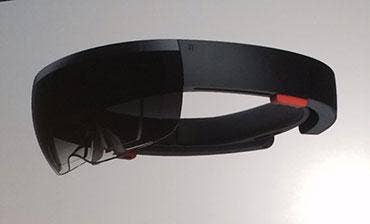Microsoft Lifts Curtain On HoloLens Headset During Windows 10 Launch

Along with the official launch of its OS upgrade, Windows 10, Microsoft Wednesday unveiled a holographic headset-based computer, dubbed HoloLens.
The device is a wearable lens set that casts a virtual screen in front of the user's eyes, according to Alex Kipman, a technical fellow in Microsoft's Operating Systems Group, during the Windows 10 launch. The headset is powered by processors such as central processing and graphics processing units, in addition to a Microsoft-developed holographic processing unit.
"This is a fully untethered holographic computer. HoloLens is real and this will be available within the Windows 10 time frame," said Kipman. "It … gives the ability to understand your gestures and voice and the ability to comprehend the space around us. This is everything you need to step into the holographic landscape."
[Related: Windows 10 Launch: Partners Offer Mixed Perspectives ]
HoloLens does not need a connection to a PC or mobile device to function properly, said Kipman, a factor that separates the wearable from other headsets such as Google Glass and the Oculus Rift.
"This will enable holographic computing … without wires, external cameras, phones or any connection to a PC needed," said Kipman. "Windows 10 will make everything people do with computers today more personal."
Microsoft, Redmond, Wash., is looking for developers to "come create experiences that aren't possible on any other device or platform," Kipman said.
Charles King, analyst at research firm Pund-IT, said the move signified a "Pandora's box opened up in the user interface space." But, he stressed, vendors of holographic headsets still have a long way to go to capture market success with consumers.
"I think it's very intriguing. … We're at a point in personal computing where the way people interact with their PCs or computational functions is changing pretty rapidly," he said. "I believe there are several business and industrial applications for this type of technology. Intel is certainly heading in that direction with their wearable technologies. But, I think we're still in the very early days for the public acceptance of this kind of technology."
Microsoft worked with NASA's Jet Propulsion Lab to develop HoloLens. The company didn't specify how much the new product would cost.
David Felton, founder of Norwalk, Conn.-based Microsoft partner Canaan Technology, said he expects HoloLens to extend the desktop to applications designed for manufacturing, health care and gaming.
"My initial reaction would have been Google Glass with a Microsoft logo, except I think Microsoft has a much better chance of getting traction with the product as it’s an extension of their 'one platform' initiative," said Felton. "Take the Microsoft Surface Pro, for example. It much more simply and eloquently extends the desktop experience to a tablet form factor versus an iPad."
NEXT: Analysts Compare HoloLens And Google Glass
HoloLens comes on the heels of Google's announcement last week that it was shelving its holographic headset, Google Glass, which would no longer be available for consumer purchase as it reworks a new Glass product.
Pund-IT's King said while HoloLens is comparable to Google Glass, the product needs to overcome several of the same hurdles that Google faced when it first launched Glass.
"To be frank, Google could have handled their Glass product a lot better," he said. "Glass was a mystery to most people. The product was used by techies with a lot of disposable income. It's too soon to say if Microsoft will overcome this, but I will say that I expect them to be mindful and careful with this new product."
PUBLISHED JAN. 21, 2015